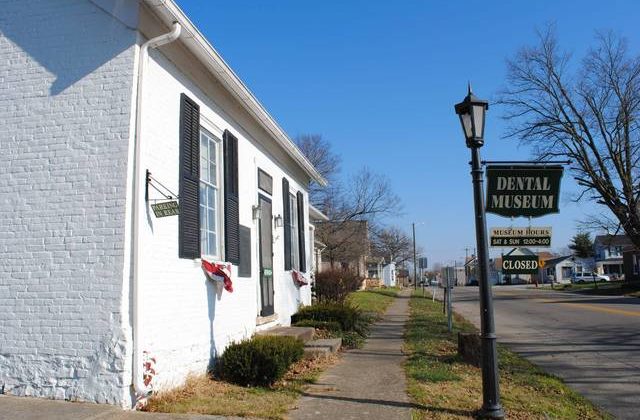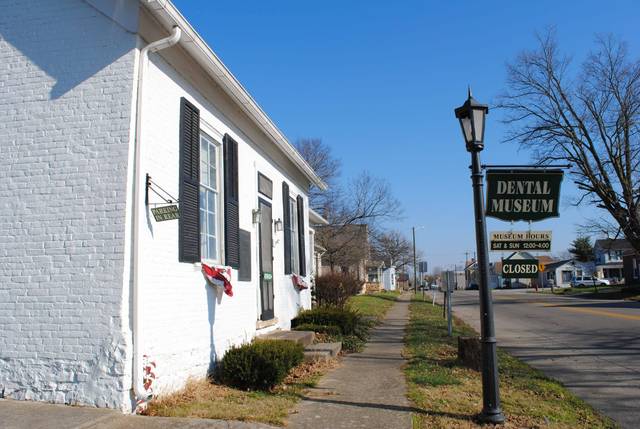
Bainbridge historical site offers local, national histories of dentistry
Story and photos by McKenzie Caldwell

On the western edge of Bainbridge, a green sign displaying the words “dental museum” sways at the side of U.S. Route 50. The unassuming white building behind the sign blends in with the residential homes around it; however, each dental college in the U.S. — and some in Canada — can trace its roots back to this Bainbridge historical site.
In 1825, Dr. John Harris moved into the house, which at that time had only three rooms, including a small bedroom with enough space for a cot and an office where he saw his patients. Harris was originally from Pompey, New York, but had spent the previous six years practicing medicine in a suburb of Cincinnati. During his time in Cincinnati, Harris became interested in dentistry, an interest he brought to Bainbridge.
On Nov. 1, 1827, The Scioto Gazette, a Chillicothe newspaper, ran an announcement from Harris entitled “Medical Instruction,” in which Harris invited young men to enroll in a private preparatory class, which would include lectures and teaching a variety of medical topics and would help prepare them to enter medical college.
When someone decided to pursue a career in medicine in those days, they apprenticed under a practicing physician and then attended a formal program at an established college, from which they received a certificate that allowed them to practice medicine. However, practicing physicians were typically only able to mentor a couple of students at a time, according to David Tillis, who serves as the president of the Bainbridge Historical Society, which has maintained the site since 1999.
The first — and only — class to study under Harris included 10 students. After instructing these students for two and a half years, Harris closed the school in 1830. But Harris’ influence on dentistry and dental education lived on. Of his 10 students, nine went on to become dentists and made major contributions to dentistry by writing books and articles, inventing tools and serving as presidents for dental organizations, Tillis said.
“We have no record that any of Dr. Harris’ students went on for additional education for further knowledge in dentistry,” Tillis said. “As far as we know, this was the extent of their dental education, other than what they learned later on from reading or experimentation or practice. This was it.”
Harris’ brother Chapin, who was a practicing physician in Greenfield before he studied dentistry under Harris, went on to co-found the world’s first dental college, the Baltimore College of Dental Surgery, in 1840. Chapin also served as the editor of the world’s first dental journal, the American Journal of Dental Science, according to an article in the December 1963 edition of the Ohio Dental Journal.
Bainbridge native Dr. James Taylor co-founded the Ohio College of Dental Surgery in Cincinnati in 1845 and served as the editor of the Dental Register of the West, which were the world’s second dental college and second dental journal respectively.
“All the modern programs in dental education in the U.S. evolved from these two schools,” Tillis said. “Prior to Dr. Harris’ time, dentistry was considered a part of medicine. If you were a medical practitioner, you learned about teeth and jaws and gums and things like that as a part of the course. Dr. Harris, both here and in his later experience, was instrumental in ‘scientificizing’ dentistry — putting it on an independent scientific basis. And his students did the same thing.”
In fact, between 1840 and 1917 alone, 104 collegiate dental programs were founded in the U.S. and Canada, all of which can be traced back to the tiny brick house in Bainbridge, according to an illustration that appeared in the March 1963 edition of The Journal of the American Dental Association.
Nationally and internationally, the Dr. John Harris Dental Museum, as Harris’ Bainbridge home and office is known today, is recognized as the first dental school in the U.S., and Harris himself is recognized as the father of modern dental education.
After leaving Bainbridge, Harris continued to practice medicine and dentistry throughout the country. Though little is known of Harris’ life, according to Tillis, Harris lived and practiced in Cincinnati, Bainbridge, Chillicothe, Indianapolis and Baltimore as well as Frankfort and Lexington in Kentucky and Fairview, Maryland.
“Dr. Harris seemed to be one of those individuals who simply could not stay in one place,” Tillis said. “It was said of Dr. Harris, even during his own lifetime, that anybody who was professionally interested in the field of dentistry knew John Harris personally because, eventually, he showed up everywhere.”
While he was in Hertford, North Carolina, Harris contracted an illness and died around the age of 51 in 1849. Harris was buried in an unmarked grave in Hertford’s public cemetery.
In 1944, nearly 100 years after Harris’ death, North Carolina’s and Ohio’s dental societies erected a stone marker that reads, “In his office at Bainbridge, Ohio, John Harris conducted the first American school in dental surgery. From this school there developed the modern system of dental education that has brought to American dentistry the highest recognition throughout the world. Honored also as being the first dentist to appreciate the result of focal infection and its effect on the general health, 1845.”
A few years later, the stone marker was replaced by a bronze marker. The stone marker now hangs on the external wall of Harris’ home in Bainbridge and is the first stop beyond the museum’s foyer during the tour.
Today, the former site of Harris’ dental school offers a glimpse into both local and dental history. The museum offers not only a tour through Harris’ original three-room home but also historical displays of dental items housed in additions built around Harris’ home.
Visitors can view a replica early 1800s dental office complete with period tools and furniture, a side-by-side comparison of dentist offices before and after electricity, and a collection of dental tools and appliances that spans centuries. During the guided tour, Tillis also corrects the legend of George Washington’s wooden teeth, revealing in the process that the first president only had one tooth when he was inaugurated for his first term.
___
Dr. John Harris Dental Museum
208 W. Main St., Bainbridge
10 a.m. to 4 p.m. weekends March to October, with year-round scheduled tours available
Admission: $5
For details or to schedule a tour, visit www.cradleofdentistry.org
Visitors should allow for one hour to take the tour and view the displays.
• To volunteer for the Bainbridge Historical Society or ehe Dr. John Harris Dental Museum, contact historical society president David Tillis at 740-626-7266 or [email protected].
ID, 'source', true); $sourcelink = get_post_meta($post->ID, 'sourcelink', true); $sourcestring = '' . __('SOURCE','gabfire') . ''; if ($sourcelink != '') { echo "
$sourcestring: $source
"; } elseif ($source != '') { echo "$sourcestring: $source
"; } // Display pagination $args = array( 'before' => '' . __('Pages:','gabfire'), 'after' => '
', 'link_before' => '', 'link_after' => '', 'next_or_number' => 'number', 'nextpagelink' => __('Next page', 'gabfire'), 'previouspagelink' => __('Previous page', 'gabfire'), 'pagelink' => '%', 'echo' => 1 ); wp_link_pages($args); // Display edit post link to site admin edit_post_link(__('Edit','gabfire'),'','
'); // Post Widget gab_dynamic_sidebar('PostWidget'); ?>